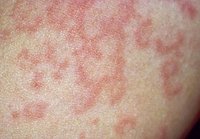 Urticaria is one of the most common dermatologic conditions seen in a clinical practice. Up to 22% of the population will experience either acute or chronic urticaria at least once in their lifetime. Broadly speaking Urticaria is defined by its duration. That lasting less than 6 weeks is acute while a longer duration is termed chronic. From an etiologic classification there is spontaneous urticaria (which is usually idiopathic), physical urticaria (such as cold-induced, heat-induced, pressure-induced, exercise-induced, etc..), and other urticarial disorders (drug induced urticaria, contact urticaria, and urticarial vasculitis). Unfortunately, the reality is that the vast majority of urticaria remains idiopathic. That is, we are idiots to the pathology of it and never find a single cause.
Urticaria is one of the most common dermatologic conditions seen in a clinical practice. Up to 22% of the population will experience either acute or chronic urticaria at least once in their lifetime. Broadly speaking Urticaria is defined by its duration. That lasting less than 6 weeks is acute while a longer duration is termed chronic. From an etiologic classification there is spontaneous urticaria (which is usually idiopathic), physical urticaria (such as cold-induced, heat-induced, pressure-induced, exercise-induced, etc..), and other urticarial disorders (drug induced urticaria, contact urticaria, and urticarial vasculitis). Unfortunately, the reality is that the vast majority of urticaria remains idiopathic. That is, we are idiots to the pathology of it and never find a single cause.
There is nothing more important than a thorough history and physical exam to make the diagnosis. If the wheals last longer than 24 hours we often recommend a skin biopsy to rule out a vasculitic etiology. We also test for other autoimmunities with a CBC, ESR, CRP, BUN, Cr, UA, Liver Panel and a Thyroid Panel. A formal allergy test with attention to both inhalants and ingestants should be considered.
Treatment of course involves an attempt at discovering and eliminating any etiologies such as ace inhibitors, aspirin, NSAIDS, beta blockers, alcohol or foods. Identifying and modifying any behavioral causes is also paramount. Beyond that, we mitigate things pharmacologically. Type 1 and 2 antihistamines are standard. 85% of the histamine receptors in the skin are H1 while 15% are H2. Doxepin is a tricyclic antidepressant with both H1 and H2 activity and is often a reasonable choice for patients. Adding a leukotriene inhibitor and necessary steroids is always considered. Beyond that, alternative chemotherapeutic options such as cyclosporine, methotrexate, dapsone, and sulfasalazine exist. Topical therapies have very little role and novel agents such as Xolair and Tacrolimus have some problems. Things of course are always changing and we will always keep up on what is emerging.
For the diffucult patient we encourage consultation to other specialists as these issues are humbling. Omalizumab or cyclosporine may be good options. While you will definitely need to check bloodwork routinely while your patients are on cyclosporine, you can obtain control quickly, and after your patient has been controlled for 4-6 months, you can wean the dose to off and maintain benefit. It might take that long simply to get omalizumab approved for this indication!
I have also seen Immuran used with success, but one must of course weigh the potentially serious side effects. The old mainstay used to be hydroxyzine. I think hydroxyzine and cetirizine (most active metabolite of hydroxyzine) are still the most effective H2 blockers for urticaria, but often the doses used are too low. FDA-approved dose of hydroxyzine is 400 mg/day (100q6). I try to push the dose up without too much sedation, and get them to 50-100 mg at least at night, and some during the day as tolerated, and tell them not to drive if necessary. The sedative effects tend to decrease with chronic use of these antihistamines. Since serum levels of cetirizine are equivalent for cetirizine 10 mg qd and hydroxyzine 50 mg qd, I often prescribe cetirizine 10-20mg during the day. (If sedated on cetirizine during the day, I use loratadine, fexofenadine etc.) If poor response, add doxepin, again with caution about sedation. Can try H1 blocker, but helps in very few patients. If still no success, try leukotriene inhibitor. Zileuton probably works best. Then try cyclosporin, omalizumab, hydroxychlorquine, dapsone etc.
Plaquenil 400 mg qd, which is the immunomodulator with the least side effects. Imuran 50 mg qd is a another option for the difficult patient. (must monitor CBC and LFT’s q 6 wk). Anecdotally, supplementing thyroid can be selectively helpful.